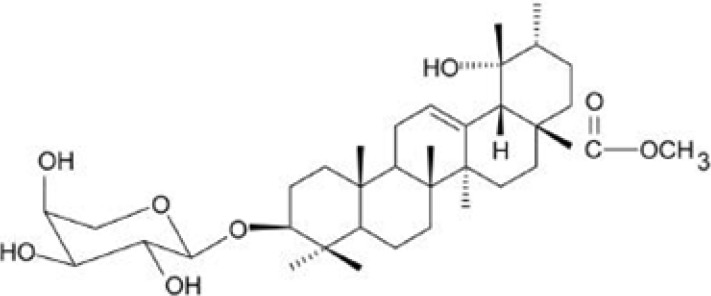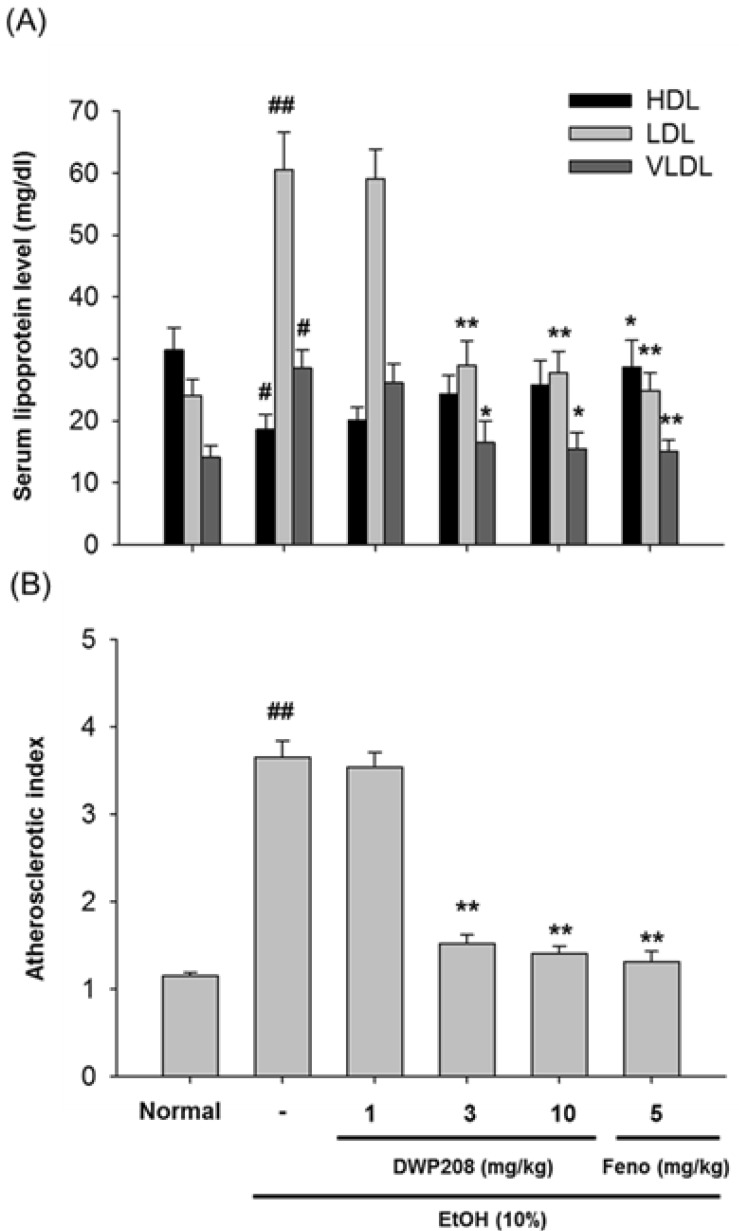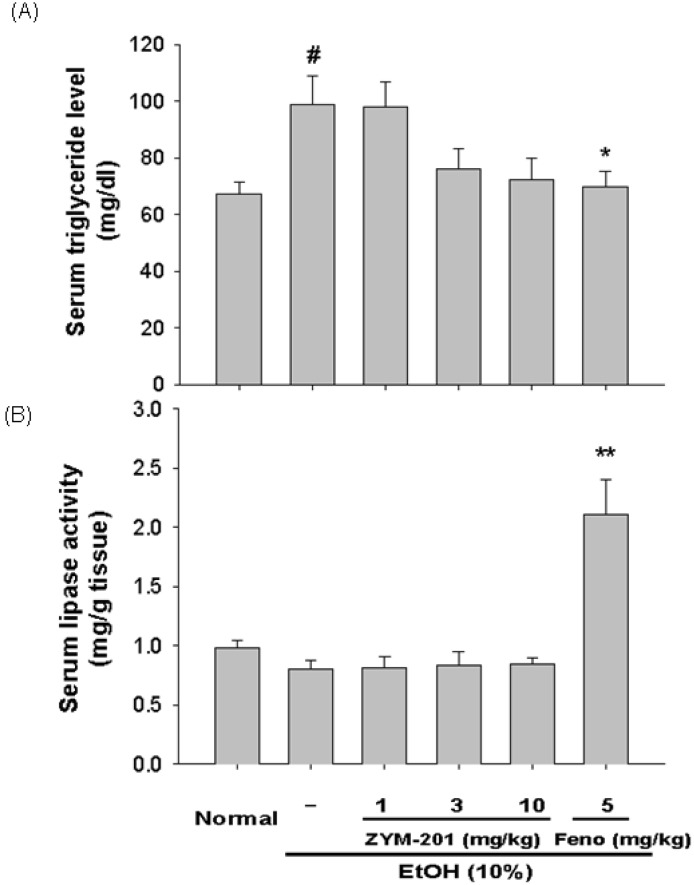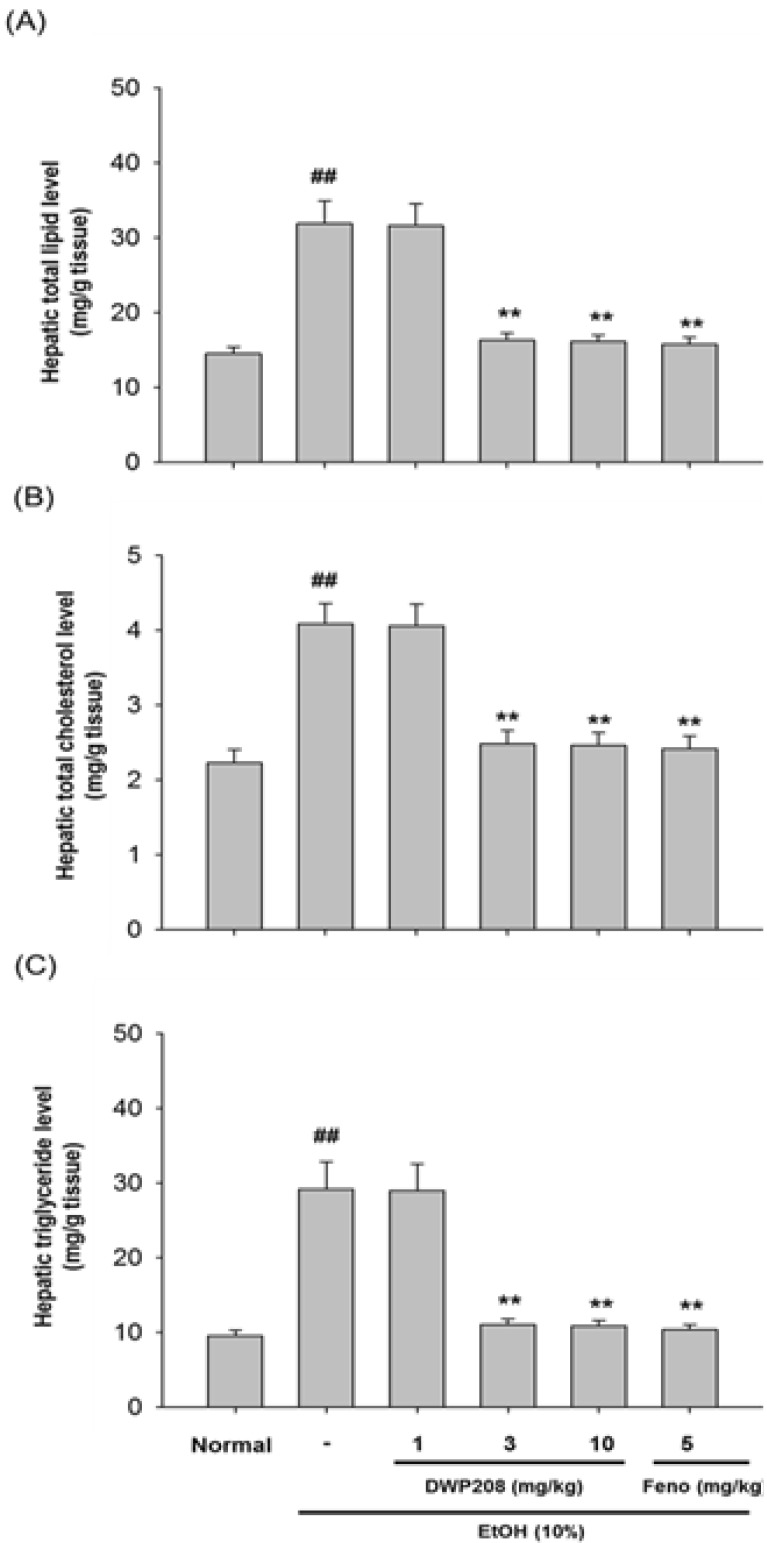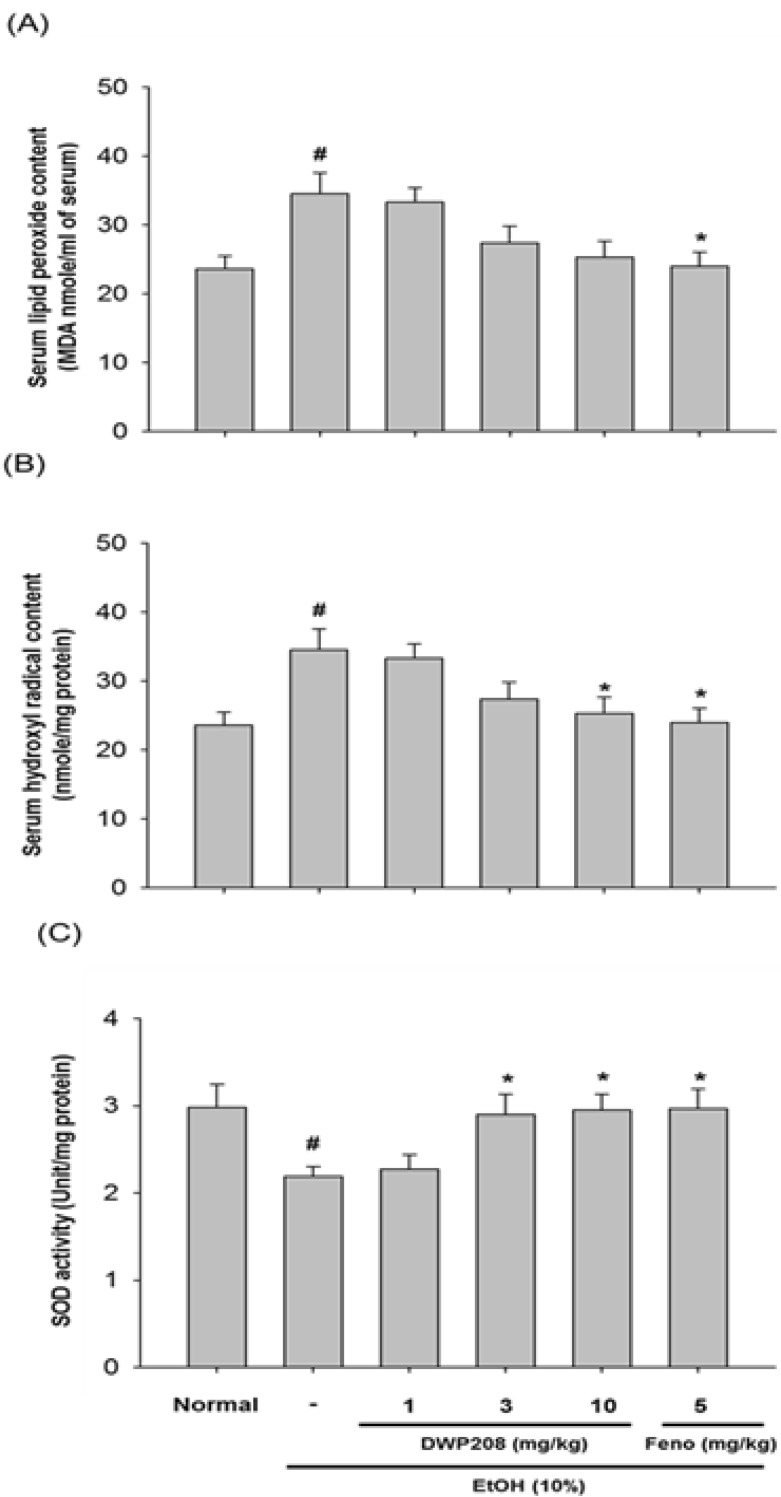Korean J Physiol Pharmacol.
2014 Dec;18(6):469-474. 10.4196/kjpp.2014.18.6.469.
Alcohol-induced Hyperlipidemia Is Ameliorated by Orally Administered DWP208, a Sodium Succinate Form of ZYM201
- Affiliations
-
- 1Department of Genetic Engineering, Sungkyunkwan University, Suwon 440-746, Korea.
- 2College of Pharmacy, Kyungsung University, Busan 608-736, Korea.
- 3Department of Animal Science, Patuakhali Science and Technology University, Barisal 8602, Bangladesh.
- 4College of Pharmacy, Chung-Ang University, Seoul 156-756, Korea. jaehwi@cau.ac.kr
- 5College of Health Sciences, Sangji University, Wonju 220-702, Korea.
- 6College of Medicine, Jeju National University, Jeju 690-756, Korea.
- 7College of Veterinary Medicine, Biosafety Research Institute, Chonbuk National University, Jeonju 561-756, Korea. jhkim1@chonbuk.ac.kr
- KMID: 2285548
- DOI: http://doi.org/10.4196/kjpp.2014.18.6.469
Abstract
- DWP208 is a sodium succinate form of ZYM-201 which is a triterpenoid glycoside isolated from Sanguisorba officinalis, a medicinal plant prescribed for various diseases, such as duodenal ulcers and bleeding in East Asian counties. We demonstrated that this compound is able to normalize the altered lipid metabolism induced by hyperglycemia and a high fat diet. In this study, we determined whether hyperlipidemic conditions induced with chronically treated alcohol can also be restored by DWP208. Similar to our previous results, orally administered DWP208 (1 to 10 mg/kg) also ameliorated the hyperlipidemia that was induced by alcohol. This compound reversed the alcohol-induced hyperlipidemia including (i) up-regulated hyperlipidemic parameters such as low-density lipoprotein (LDL), very low-density lipoprotein (VLDL), atherosclerotic index (AI), triglyceride, and total cholesterol, and (ii) down-regulated hyperlipidemic parameters such as absolute body weight, superoxide dismutase (SOD) activity, and high-density lipoprotein (HDL) in serum and liver. According to our data, the ameliorative activity of DWP208 is due to its indirect anti-oxidative activity as a result of which lipid peroxide and hydroxyl radical levels were reduced and the activity of SOD was enhanced. Therefore, our data strongly suggest that DWP208 can be used as a remedy against alcohol-induced hyperlipidemia.
Keyword
MeSH Terms
-
Asian Continental Ancestry Group
Body Weight
Cholesterol
Diet, High-Fat
Duodenal Ulcer
Hemorrhage
Humans
Hydroxyl Radical
Hyperglycemia
Hyperlipidemias*
Lipid Metabolism
Lipoproteins
Liver
Plants, Medicinal
Sanguisorba
Sodium*
Succinic Acid*
Superoxide Dismutase
Triglycerides
Cholesterol
Hydroxyl Radical
Lipoproteins
Sodium
Succinic Acid
Superoxide Dismutase
Figure
Reference
-
1. Maxwell JC. Update: comparison of drug use in Australia and the United States as seen in the 2001 National Household Surveys. Drug Alcohol Rev. 2003; 22:347–357. PMID: 15385229.
Article2. Thomson SJ, Westlake S, Rahman TM, Cowan ML, Majeed A, Maxwell JD, Kang JY. Chronic liver disease--an increasing problem: a study of hospital admission and mortality rates in England, 1979-2005, with particular reference to alcoholic liver disease. Alcohol Alcohol. 2008; 43:416–422. PMID: 18385412.
Article3. You M, Crabb DW. Recent advances in alcoholic liver disease II. Minireview: molecular mechanisms of alcoholic fatty liver. Am J Physiol Gastrointest Liver Physiol. 2004; 287:G1–G6. PMID: 15194557.
Article4. Arteel GE, Iimuro Y, Yin M, Raleigh JA, Thurman RG. Chronic enteral ethanol treatment causes hypoxia in rat liver tissue in vivo. Hepatology. 1997; 25:920–926. PMID: 9096598.5. Albano E. Oxidative mechanisms in the pathogenesis of alcoholic liver disease. Mol Aspects Med. 2008; 29:9–16. PMID: 18045675.
Article6. Deaciuc IV, Doherty DE, Burikhanov R, Lee EY, Stromberg AJ, Peng X, de Villiers WJ. Large-scale gene profiling of the liver in a mouse model of chronic, intragastric ethanol infusion. J Hepatol. 2004; 40:219–227. PMID: 14739091.
Article7. Chait A, Mancini M, February AW, Lewis B. Clinical and metabolic study of alcoholic hyperlipidaemia. Lancet. 1972; 2:62–64. PMID: 4113305.8. Lefevre AF, DeCarli LM, Lieber CS. Effect of ethanol on cholesterol and bile acid metabolism. J Lipid Res. 1972; 13:48–55. PMID: 5059198.9. Cho JY, Yoo ES, Cha BC, Park HJ, Rhee MH, Han YN. The inhibitory effect of triterpenoid glycosides originating from Sanguisorba officinalis on tissue factor activity and the production of TNF-alpha. Planta Med. 2006; 72:1279–1284. PMID: 17022001.10. Asao Y, Morikawa T, Xie Y, Okamoto M, Hamao M, Matsuda H, Muraoka O, Yuan D, Yoshikawa M. Structures of acetylated oleanane-type triterpene saponins, rarasaponins IV, V, and VI, and anti-hyperlipidemic constituents from the pericarps of Sapindus rarak. Chem Pharm Bull (Tokyo). 2009; 57:198–203. PMID: 19182412.
Article11. Liu SJ, Ramsey RK, Fallon HJ. Effects of ethanol on hepatic microsomal drug-metabolizing enzymes in the rat. Biochem Pharmacol. 1975; 24:369–378. PMID: 1125043.
Article12. Yuan Q, Shi H. Treatment of hyperlipemia by acupoint catgutembedding in 34 cases. J Tradit Chin Med. 2003; 23:208. PMID: 14535193.13. Takahashi T, Hirano T, Okada K, Adachi M. Apolipoprotein CIII deficiency prevents the development of hypertriglyceridemia in streptozotocin-induced diabetic mice. Metabolism. 2003; 52:1354–1359. PMID: 14564689.
Article14. Sagone AL Jr, Decker MA, Wells RM, Democko C. A new method for the detection of hydroxyl radical production by phagocytic cells. Biochim Biophys Acta. 1980; 628:90–97. PMID: 6892610.15. Giada F, Baldo-Enzi G, Balocchi MR, Zuliani G, Baroni L, Fellin R. Heparin-released plasma lipase activities, lipoprotein and apoprotein levels in young adult cyclists and sedentary men. Int J Sports Med. 1988; 9:270–274. PMID: 3141306.
Article16. Fraga CG, Leibovitz BE, Tappel AL. Lipid peroxidation measured as thiobarbituric acid-reactive substances in tissue slices: characterization and comparison with homogenates and microsomes. Free Radic Biol Med. 1988; 4:155–161. PMID: 3356355.
Article17. Wahlund G, Marklund SL, Sjöquist PO. Extracellular-superoxide dismutase type C (EC-SOD C) reduces myocardial damage in rats subjected to coronary occlusion and 24 hours of reperfusion. Free Radic Res Commun. 1992; 17:41–47. PMID: 1446846.
Article18. Ametaj BN, Bobe G, Lu Y, Young JW, Beitz DC. Effect of sample preparation, length of time, and sample size on quantification of total lipids from bovine liver. J Agric Food Chem. 2003; 51:2105–2110. PMID: 12670142.
Article19. Bradford MM. A rapid and sensitive method for the quantitation of microgram quantities of protein utilizing the principle of protein-dye binding. Anal Biochem. 1976; 72:248–254. PMID: 942051.
Article20. Choi J, Kim MY, Cha BC, Yoo ES, Yoon K, Lee J, Rho HS, Kim SY, Cho JY. ZYM-201 sodium succinate ameliorates streptozotocin-induced hyperlipidemic conditions. Planta Med. 2012; 78:12–17. PMID: 21928167.
Article21. Grauvogel J, Daemmrich TD, Ryschich E, Gebhard MM, Werner J. Chronic alcohol intake increases the severity of pancreatitis induced by acute alcohol administration, hyperlipidemia and pancreatic duct obstruction in rats. Pancreatology. 2010; 10:603–612. PMID: 20980778.
Article22. Wang Z, Yao T, Song Z. Chronic alcohol consumption disrupted cholesterol homeostasis in rats: down-regulation of low-density lipoprotein receptor and enhancement of cholesterol biosynthesis pathway in the liver. Alcohol Clin Exp Res. 2010; 34:471–478. PMID: 20028367.
Article23. Vinik AI. The metabolic basis of atherogenic dyslipidemia. Clin Cornerstone. 2005; 7:27–35. PMID: 16473258.
Article24. Albano E. Alcohol, oxidative stress and free radical damage. Proc Nutr Soc. 2006; 65:278–290. PMID: 16923312.
Article25. Hiramatsu M, Edamatsu R, Mori A. Free radicals, lipid peroxidation, SOD activity, neurotransmitters and choline acetyltransferase activity in the aged rat brain. EXS. 1992; 62:213–218. PMID: 1360282.
Article26. Liu ZQ, Luo XY, Liu GZ, Chen YP, Wang ZC, Sun YX. In vitro study of the relationship between the structure of ginsenoside and its antioxidative or prooxidative activity in free radical induced hemolysis of human erythrocytes. J Agric Food Chem. 2003; 51:2555–2558. PMID: 12696936.
Article27. Liu TZ, Lee KT, Chern CL, Cheng JT, Stern A, Tsai LY. Free radical-triggered hepatic injury of experimental obstructive jaundice of rats involves overproduction of proinflammatory cytokines and enhanced activation of nuclear factor kappaB. Ann Clin Lab Sci. 2001; 31:383–390. PMID: 11688850.28. Wang P, Niu L, Guo XD, Gao L, Li WX, Jia D, Wang XL, Ma LT, Gao GD. Gypenosides protects dopaminergic neurons in primary culture against MPP(+)-induced oxidative injury. Brain Res Bull. 2010; 83:266–271. PMID: 20615455.
Article
- Full Text Links
- Actions
-
Cited
- CITED
-
- Close
- Share
- Similar articles
-
- Succinate Induces Liver Damage and Hepatic Fibrosis in a Mouse Model
- Phloretin Ameliorates Succinate-Induced Liver Fibrosis by Regulating Hepatic Stellate Cells
- Pseudohyponatremia:Does It Matter in Current Clinical Practice?
- A case of anaphylactic shock induced by hydrocortisone sodium succinate in patient with wheat allergy
- Multifaceted Actions of Succinate as a Signaling Transmitter Vary with Its Cellular Locations

